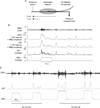Repeated psychological stress-induced alterations of visceral sensitivity and colonic motor functions in mice: influence of surgery and postoperative single housing on visceromotor responses
- PMID: 20536336
- PMCID: PMC3295848
- DOI: 10.3109/10253891003664166
Repeated psychological stress-induced alterations of visceral sensitivity and colonic motor functions in mice: influence of surgery and postoperative single housing on visceromotor responses
Abstract
Visceral pain modulation by chronic stress in mice has been little studied. Electromyography (EMG) recording of abdominal muscle contractions, as a proxy to the visceromotor response (VMR), requires electrode implantation and post-surgical single housing (SH) which could affect the VMR to stress. To test this hypothesis, male mice had electrode implantation surgery (S) plus SH, or no surgery and were group housed (NS-GH) or single housed (NS-SH) and exposed to either water avoidance stress (WAS, 1 h/day) or left undisturbed in their home cages for 10 days. The VMR to phasic ascending colorectal distension (CRD) was assessed before (basal) and 24 h after 10 days of WAS or no stress using a surgery-free method of intraluminal colonic pressure (ICP) recording (solid-state manometry). WAS heightened significantly the VMR to CRD at 30, 45, and 60 mmHg in S-SH vs. NS-GH, but not compared to NS-SH conscious mice. Compared to basal CRD, WAS increased VMR at 60 mmHg in the S-SH group and decreased it at 30-60 mmHg in NS-GH mice, while having no effect in NS-SH mice. The average defecation during the hour of repeated WAS over 10 days was 1.9 and 2.4 fold greater in S-SH vs. NS-GH and NS-SH mice, respectively. These data indicate that the combination of S-SH required for VMR monitoring with EMG is an important component of repeated WAS-induced post-stress visceral hypersensitivity and defecation in mice.
Conflict of interest statement
Figures






Similar articles
-
Stress-induced visceral analgesia assessed non-invasively in rats is enhanced by prebiotic diet.World J Gastroenterol. 2012 Jan 21;18(3):225-36. doi: 10.3748/wjg.v18.i3.225. World J Gastroenterol. 2012. PMID: 22294825 Free PMC article.
-
Psychological stress and the severity of post-inflammatory visceral hyperalgesia.Eur J Pain. 2007 Feb;11(2):216-22. doi: 10.1016/j.ejpain.2006.02.007. Epub 2006 Mar 20. Eur J Pain. 2007. PMID: 16545971
-
A model for chronic quantitative studies of colorectal sensitivity using balloon distension in conscious mice -- effects of opioid receptor agonists.Neurogastroenterol Motil. 2003 Aug;15(4):371-81. doi: 10.1046/j.1365-2982.2003.00418.x. Neurogastroenterol Motil. 2003. PMID: 12846725
-
Visceral analgesia induced by acute and repeated water avoidance stress in rats: sex difference in opioid involvement.Neurogastroenterol Motil. 2012 Nov;24(11):1031-e547. doi: 10.1111/j.1365-2982.2012.01980.x. Epub 2012 Jul 9. Neurogastroenterol Motil. 2012. PMID: 22776034 Free PMC article.
-
Role of corticotropin-releasing factor pathways in stress-related alterations of colonic motor function and viscerosensibility in female rodents.Gend Med. 2005 Sep;2(3):146-54. doi: 10.1016/s1550-8579(05)80043-9. Gend Med. 2005. PMID: 16290887 Review.
Cited by
-
Stress-induced visceral pain: toward animal models of irritable-bowel syndrome and associated comorbidities.Front Psychiatry. 2015 Feb 16;6:15. doi: 10.3389/fpsyt.2015.00015. eCollection 2015. Front Psychiatry. 2015. PMID: 25762939 Free PMC article. Review.
-
Effects of experimental housing conditions on recovery of laboratory mice.Lab Anim (NY). 2015 Feb;44(2):65-70. doi: 10.1038/laban.662. Lab Anim (NY). 2015. PMID: 25602397 Review.
-
Mice do not habituate to metabolism cage housing--a three week study of male BALB/c mice.PLoS One. 2013;8(3):e58460. doi: 10.1371/journal.pone.0058460. Epub 2013 Mar 7. PLoS One. 2013. PMID: 23505511 Free PMC article.
-
Fecal dysbiosis associated with colonic hypersensitivity and behavioral alterations in chronically Blastocystis-infected rats.Sci Rep. 2020 Jun 4;10(1):9146. doi: 10.1038/s41598-020-66156-w. Sci Rep. 2020. PMID: 32499543 Free PMC article.
-
AhR/IL-22 pathway as new target for the treatment of post-infectious irritable bowel syndrome symptoms.Gut Microbes. 2022 Jan-Dec;14(1):2022997. doi: 10.1080/19490976.2021.2022997. Gut Microbes. 2022. PMID: 35090380 Free PMC article.
References
-
- Ait-Belgnaoui A, Bradesi S, Fioramonti J, Theodorou V, Buéno L. Acute stress-induced hypersensitivity to colonic distension depends upon increase in paracellular permeability: Role of myosin light chain kinase. Pain. 2005;113:141–147. - PubMed
-
- Al-Chaer ED, Kawasaki M, Pasricha PJ. A new model of chronic visceral hypersensitivity in adult rats induced by colon irritation during postnatal development. Gastroenterology. 2000;119:1276–1285. - PubMed
-
- Arvidsson S, Larsson M, Larsson H, Lindstrom E, Martinez V. Assessment of visceral pain-related pseudo-affective responses to colorectal distension in mice by intracolonic manometric recordings. J Pain. 2006;7:108–118. - PubMed
-
- Banik RK, Subieta AR, Wu C, Brennan TJ. Increased nerve growth factor after rat plantar incision contributes to guarding behavior and heat hyperalgesia. Pain. 2005;117:68–76. - PubMed
-
- Bartolomucci A, Palanza P, Sacerdote P, Ceresini G, Chirieleison A, Panerai AE, Parmigiani S. Individual housing induces altered immuno-endocrine responses to psychological stress in male mice. Psychoneuroendocrinology. 2003;28:540–558. - PubMed
Publication types
MeSH terms
Substances
Grants and funding
- R37 DK033061/DK/NIDDK NIH HHS/United States
- DK41301/DK/NIDDK NIH HHS/United States
- T32 DK007180/DK/NIDDK NIH HHS/United States
- P50 DK-64539/DK/NIDDK NIH HHS/United States
- DK-33061/DK/NIDDK NIH HHS/United States
- R01 DK078676/DK/NIDDK NIH HHS/United States
- T32 DK07180-33/DK/NIDDK NIH HHS/United States
- R01 DK057238/DK/NIDDK NIH HHS/United States
- R01DK-57238/DK/NIDDK NIH HHS/United States
- AM41301/AM/NIADDK NIH HHS/United States
- R01 DK033061/DK/NIDDK NIH HHS/United States
- P30 DK041301/DK/NIDDK NIH HHS/United States
- DK-78676/DK/NIDDK NIH HHS/United States
- P50 DK064539/DK/NIDDK NIH HHS/United States
LinkOut - more resources
Full Text Sources
Other Literature Sources
Medical
Miscellaneous
